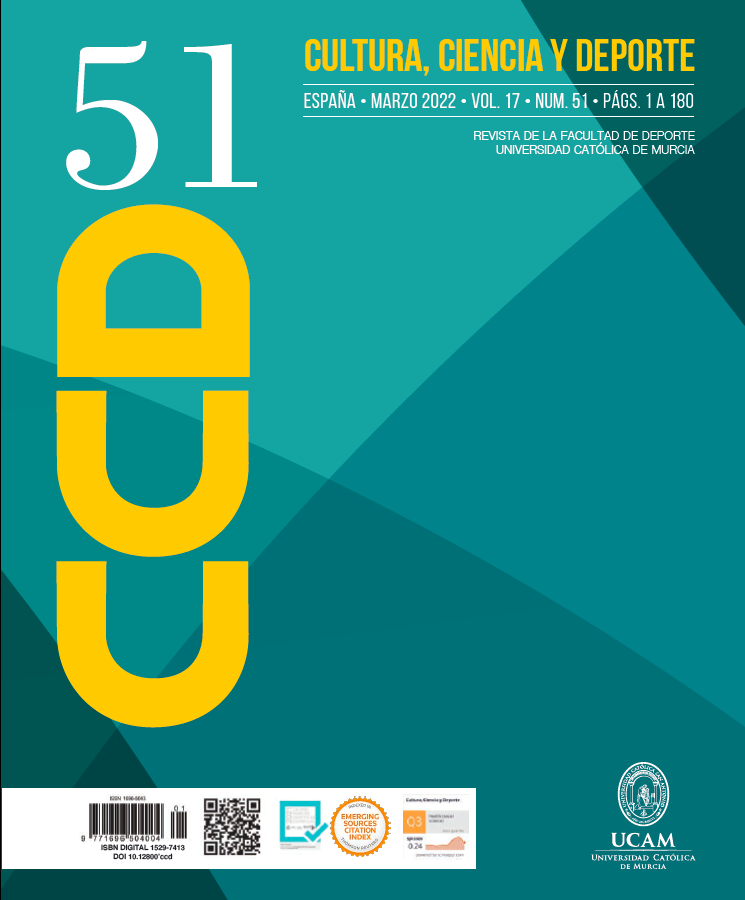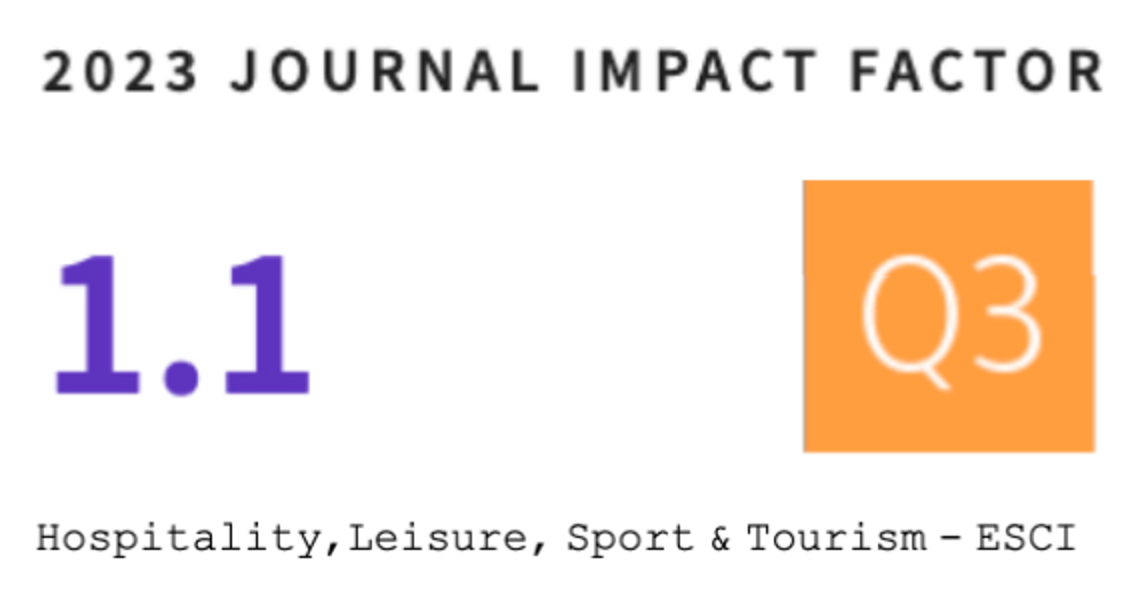Analysis of the neuromuscular responses associated with High-Intensity Interval Training in cyclic and acyclic athletes
DOI:
https://doi.org/10.12800/ccd.v17i51.1711Keywords:
Explosive strength, intermittent exercise, vertical ground reaction force, neuromuscular fatigue.Abstract
The purpose of the present study was to investigate the effect of high-intensity interval training (HIIT) on countermovement jump performance. Twenty-two male regional-level athletes (cyclic, n = 11; acyclic, n = 11) completed two HIIT sessions on separate days. A different work-interval duration was applied in each session to determine the short and long protocols. Countermovement jump tests were executed pre-effort and at the end of all series to assess the effect of fatigue on jumping performance. A decrease in jump performance was observed at the end of the third series (p < .001), and different jumping strategies were displayed by cyclic and acyclic athletes, expressed as significant differences in the velocity components, and in the performance outcomes during the braking sub-phase (p < .01). These differences also conditioned the neuromuscular responses to HIIT, affecting specific variables depending on the sport discipline. In conclusion, neuromuscular status was principally affected by the total series completed rather than by the type of protocol implemented. The present findings may be useful when conducting HIIT concurrently with other training contents.References
Barker L.A., Harry J.R., & Mercer J.A. (2018). Relationships between countermovement jump ground reaction forces and jump height, reactive strength index, and jump time. Journal of Strength and Conditioning Research, 32, 248-254. https://doi.org/10.1519/JSC.0000000000002160
Bedo B.L.S., Pereira D.R., Moraes R., Kalva-Filho C.A., Will-de-Lemos T., & Santiago P.R.P. (2020). The rapid recovery of vertical force propulsion production and postural sway after a specific fatigue protocol in female handball athletes. Gait & Posture, 77, 52-58. https://doi.org/10.1016/j.gaitpost.2020.01.017
Benjaminse A., Habu A., Sell T.C., Abt J.P., Fu F.H., Myers J.B., & Lephart S.M. (2008). Fatigue alters lower extremity kinematics during a single-leg stop-jump task. Knee Surgery, Sports Traumatology, Arthroscopy, 16, 400-407. https://doi.org/10.1007/s00167-007-0432-7
Billat V.L., Slawinski J., Bocquet V., Demarle A., Lafitte L., Chassaing P., & Koralsztein J-P. (2000). Intermittent runs at the velocity associated with maximal oxygen uptake enables subjects to remain at maximal oxygen uptake for a longer time than intense but submaximal runs. European journal of applied physiology, 81, 188-196. https://doi.org/10.1007/s004210050029
Buchheit M. & Laursen P. (2013). High-intensity training, solutions to the programming puzzle. Part II: anaerobic energy, neuromuscular load and practical applications. Sports Med, 43, 927-954. https://doi.org/10.1007/s40279-013-0066-5
Claudino J.G., Cronin J., Mezêncio B., McMaster D.T., McGuigan M., Tricoli V., Amadio A.C., & Serrão J.C. (2017). The countermovement jump to monitor neuromuscular status: A meta-analysis. Journal of science and medicine in sport, 20, 397-402. https://doi.org/10.1016/j.jsams.2016.08.011
Cormack S.J., Newton R.U., McGuigan M.R., & Cormie P. (2008). Neuromuscular and endocrine responses of elite players during an Australian rules football season. International Journal of Sports Physiology and Performance, 3, 439-453. https://doi.org/10.1123/ijspp.3.4.439
Cormie P., McGuigan M.R., & Newton R.U. (2010). Changes in the eccentric phase contribute to improved stretch-shorten cycle performance after training. Medicine & Science in Sports & Exercise, 42, 1731-1744. https://doi.org/10.1249/mss.0b013e3181d392e8
Dupont G., Blondel N., Lensel G., & Berthoin S. (2002). Critical velocity and time spent at a high level of for short intermittent runs at supramaximal velocities. Canadian journal of applied physiology, 27, 103-115. https://doi.org/10.1139/h02-008
Garrett J., Graham S.R., Eston R.G., Burgess D.J., Garrett L.J., Jakeman J., & Norton K. (2019). A Novel Method of Assessment for Monitoring Neuromuscular Fatigue in Australian Rules Football Players. International journal of sports physiology and performance, 14, 598-605. https://doi.org/10.1123/ijspp.2018-0253
Gathercole R., Sporer B., Stellingwerff T., & Sleivert G. (2015). Alternative Countermovement-jump analysis to quantify acute neuromuscular fatigue. International journal of sports physiology and performance, 10, 84-92. https://doi.org/10.1123/ijspp.2013-0413
Griffiths B., Grant J., Langdown L., Gentil P., Fisher J., & Steele J. (2019). The Effect of In-Season Traditional and Explosive Resistance Training Programs on Strength, Jump Height, and Speed in Recreational Soccer Players. Research Quarterly for Exercise and Sport, 90, 95-102. https://doi.org/10.1080/02701367.2018.1563276
Harry J.R., Paquette M.R., Schilling B.K., Barker L.A., James C.R., & Dufek J.S. (2018). Kinetic and electromyographic subphase characteristics with relation to countermovement vertical jump performance. Journal of Applied Biomechanics, 34, 291-297. https://doi.org/10.1123/jab.2017-0305
Hori N., Newton R.U., Kawamori N., McGuigan M.R., Kraemer W.J., & Nosaka K. (2009). Reliability of performance measurements derived from ground reaction force data during countermovement jump and the influence of sampling frequency. Journal of Strength Conditioning Research, 23, 874-882. https://doi.org/10.1519/JSC.0b013e3181a00ca2
Jordan M.J., Aagaard P., & Herzog W. (2018). A comparison of lower limb stiffness and mechanical muscle function in ACL-reconstructed, elite, and adolescent alpine ski racers/ski cross athletes. Journal of Sport and Health Science, 7, 416-424. https://doi.org/10.1016/j.jshs.2018.09.006
Kirby T.J., McBride J.M., Haines T.L., & Dayne A.M. (2011). Relative net vertical impulse determines jumping performance. Journal of Applied Biomechanics, 27, 207-214. https://doi.org/10.1123/jab.27.3.207
Laffaye G., Wagner P.P., & Tombleson T.I. (2014). Countermovement jump height: Gender and sport-specific differences in the force-time variables. Journal of Strength & Conditioning Research, 28, 1096-1105. https://doi.org/10.1519/JSC.0b013e3182a1db03
McLellan C., Lovell D., & Gass G. (2011). The role of rate of force development on vertical jump performance. Journal of Strength & Conditioning Research, 25, 379-385. https://doi.org/10.1519/JSC.0b013e3181be305c
McMahon J.J., Rej S.J., & Comfort P. (2017). Sex differences in countermovement jump phase characteristics. Sports, 5, 8. https://doi.org/10.3390/sports5010008
Moir G.L. (2008). Three Different Methods of Calculating Vertical Jump Height from Force Platform Data in Men and Women. Measurement in Physical Education and Exercise Science, 12, 207-218. https://doi.org/10.1080/10913670802349766
Price M., & Moss P. (2007). The effects of work: rest duration on physiological and perceptual responses during intermittent exercise and performance. Journal of sports sciences, 25, 1613-1621. https://doi.org/10.1080/02640410701287248
Rodacki A.L.F., Fowler N.E., & Bennett S.J. (2002). Vertical jump coordination: fatigue effects. Medicine & Science in sports & exercise, 34, 105-116. https://doi.org/10.1097/00005768-200201000-00017
Rozenek R., Funato K., Kubo J., Hoshikawa M., & Matsuo A. (2007). Physiological responses to interval training sessions at velocities associated with VO2 max. Journal of Strength and Conditioning Research, 21, 188-192. https://doi.org/10.1519/R-19325.1
Sole C.J., Mizuguchi S., Sato K., Moir G.L., & Stone M.H. (2018). Phase characteristics of the countermovement jump force-time curve: A comparison of athletes by jumping ability. Journal of Strength and Conditioning Research, 32, 1155-1165. https://doi.org/10.1519/JSC.0000000000001945
Thorlund J., Michalsik L., Madsen K., & Aagaard P. (2008). Acute fatigue‐induced changes in muscle mechanical properties and neuromuscular activity in elite handball players following a handball match. Scand J Med Sci Sports, 18, 462-472. https://doi.org/10.1111/j.1600-0838.2007.00710.x
Tschakert G., & Hofmann P. (2013). High-intensity intermittent exercise: methodological and physiological aspects. International Journal of Sports Physiology and Performance, 8, 600-610. https://doi.org/10.1123/ijspp.8.6.600
Tschakert G., Kroepfl J., Mueller A., Moser O., Groeschl W., & Hofmann P. (2015). How to regulate the acute physiological response to “aerobic” high-intensity interval exercise. Journal of sports science & medicine, 14, 29-36.
Wakefield B.R., & Glaister M. (2009). Influence of Work-Interval Intensity and Duration on Time Spent at a High Percentage VO2max During Intermittent Supramaximal Exercise. Journal of Strength and Conditioning Research, 23, 2548-2554. https://doi.org/10.1519/JSC.0b013e3181bc19b1
Warr-di Piero D., Valverde-Esteve T., Redondo-Castán J.C., Pablos-Abella C., & Sánchez-Alarcos Díaz-Pintado J.V. (2018). Effects of work-interval duration and sport specificity on blood lactate concentration, heart rate and perceptual responses during high intensity interval training. PloS One, 13, e0200690. https://doi.org/10.1371/journal.pone.0200690
Warr D.M., Pablos C., Sánchez-Alarcos J.V., Torres V., Izquierdo J.M., and Redondo J.C. (2020). Reliability of measurements during countermovement jump assessments: Analysis of performance across subphases. Cogent Social Sciences, 6, 1843835. https://doi.org/10.1080/23311886.2020.1843835
Watkins C.M., Barillas S.R., Wong M.A., Archer D.C., Dobbs I.J., Lockie R.G., Coburn J.W., Tran T.T., & Brown L.E. (2017). Determination of vertical jump as a measure of neuromuscular readiness and fatigue. Journal of Strength and Conditioning Research, 31, 3305-3310. https://doi.org/10.1519/JSC.0000000000002231
Wilson J.M., Marin P.J., Rhea M.R., Wilson S.M., Loenneke J.P., & Anderson J.C. (2012). Concurrent training: a meta-analysis examining interference of aerobic and resistance exercises. Journal of Strength and Conditioning Research, 26, 2293-2307. https://doi.org/10.1519/JSC.0b013e31823a3e2d
Zafeiridis A., Kounoupis A., Dipla K., Kyparos A., Nikolaidis M., Smilios I., & Vrabas I. (2015). Oxygen delivery and muscle deoxygenation during continuous, long-and short-interval exercise. International journal of sports medicine, 94, 872-880. https://doi.org/10.1055/s-0035-1554634
Published
How to Cite
Issue
Section
License
Copyright (c) 2022 Creative Commons Attribution License

This work is licensed under a Creative Commons Attribution-NonCommercial-ShareAlike 4.0 International License.
The authors who publish in this journal agree with the following terms:
- The authors retain the copyright and guarantee the journal the right to be the first publication of the work as well as licensed under a Creative Commons Attribution License that allows others to share the work with recognition of the authorship of the work and the initial publication in this journal.
















